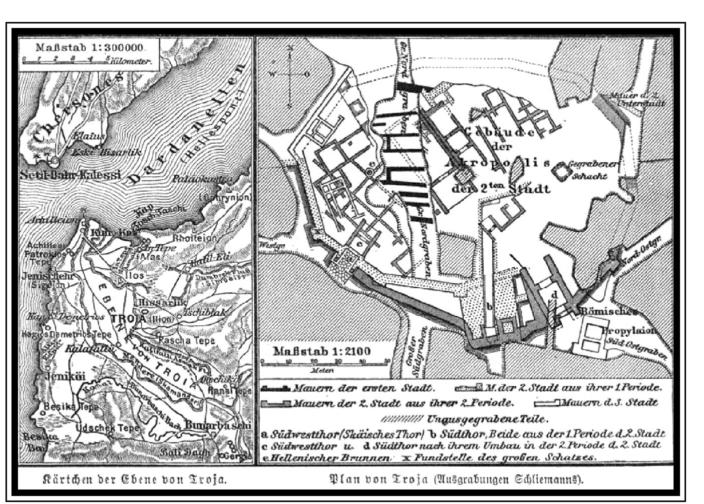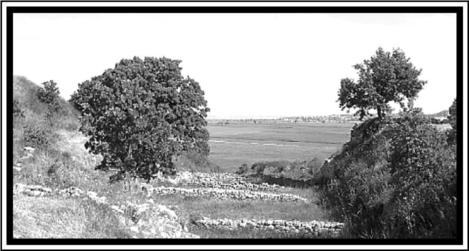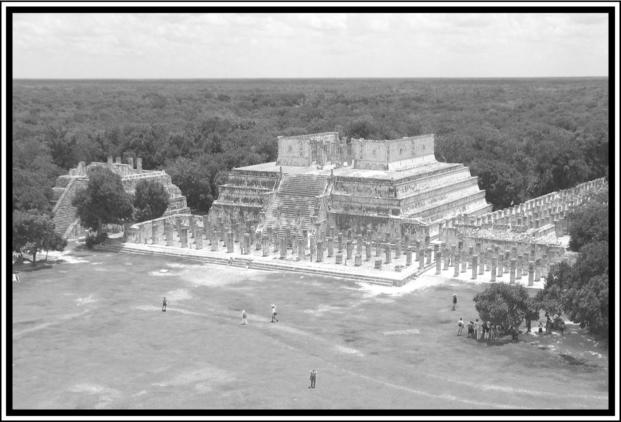Hidden History: Lost Civilizations, Secret Knowledge, and Ancient Mysteries (8 page)
Read Hidden History: Lost Civilizations, Secret Knowledge, and Ancient Mysteries Online
Authors: Brian Haughton
Tags: #Fringe Science, #Gnostic Dementia, #U.S.A., #Alternative History, #Amazon.com, #Retail, #Archaeology, #History

There has been much debate about
whether or not Schliemann actually
found the gold artifacts in the place
where he claimed, or if he had them
planted there to verify his claims that
the site was in fact the fabled city of
Troy. Schliemann is known to have
distorted the facts on more than one
occasion. Although he claimed to have
discovered the site of Troy at Hisarlik
himself, when Schliemann first visited
the Troad, English archaeologist and
diplomat Frank Calvert had already
been excavating on part of Hisarlik for
some time, as it was on his family's
land. Calvert was convinced Hisarlik
was the site of ancient Troy and later
collaborated with Schliemann on his
early excavation on the hill. However,
when Schliemann later received
worldwide acclaim for discovering the
Homeric city, he refused to admit that
Calvert had anything to do with the
discovery. Currently, English and
American heirs of Frank Calvert are
pursuing claims for a portion of the
treasure that Schliemann and Calvert
recovered from the site of Hisarlik. The
spectacular gold finds discovered by Schliemann are now believed to have
come from a much earlier city on the
Hisarlik mound than he believed. The
city Schliemann thought was Homer's
Troy in fact dates from 2400 to 2200
B.C., at least 1,000 years before the generally accepted date for the Trojan
War.

1880 map of Troy.
Despite Schliemann's egotistical
attitude, he did bring the site of
Hisarlik to the attention of the world.
After his excavations, further work at
Hisarlik was undertaken by Wilhelm
Dorpfeld (1893-1894), American
archaeologist Carl Blegen from 1932
to 1938, and from 1988 to 2005 by a
team of the University of Tubingen
and the University of Cincinnati, under the direction of the late Professor
Manfred Korfmann. Excavations at
Troy have shown that there were nine
separate phases and cities at the site,
with various sub-phases. These phases
begin in the third millennium B.C.
(early Bronze Age) with Troy I and finish in the Hellenistic period (323 B.C.-
c. 31 B.C.) with Troy IX. The Late
Bronze Age phase Troy VIIa (c. 1300c. 1180 B.C.) is the city usually put forward as the most likely candidate for
Homer's Troy, mainly due to its date,
which seems to tie in with Homer's
descriptions, and the fact that traces
of fire indicate that the city was destroyed during a war. Contact between
mainland Greece and Troy VIIa is attested to in the form of imported
Mycenaean (Late Bronze Age) Greek
artifacts, especially pottery. Furthermore, the city of Troy VIIa was of considerable size, and finds including
partial human remains and some
bronze arrowheads have been made in
the fort and city. However, a large part
of Troy VIIa remains unexcavated, and
the finds are generally too meager to
argue with certainty that the destruction of the site was done by human
hands over that of a natural catastrophe, such as a massive earthquake.
Nevertheless, if we are to interpret the
Homeric city of Troy as a historical
truth, then on present knowledge
Troy VIIa would seem to fit the facts
best. Recently, evidence that would
seem to support the view of the
Hisarlik mound as the site of Troy was
revealed by geologists John C. Kraft
from the University of Delaware, and
John V. Luce from Trinity College,
Dublin. The pair undertook a geological study of the landscape and coastal
features of the area around Hisarlik,
which revealed that the region's sedimentology and geomorphology are consistent with the features described in
Homer's Iliad.
There may even be some historical fact behind what is perhaps the
most outlandish detail in Homer's
narrative-the colossal Trojan Horse.
English historian Michael Wood has
suggested that rather than being a
clever ploy to get inside the city, the
Trojan horse might actually represent
a large battering ram or primitive
siege engine resembling a horse. Such
devices are known from Classical
Greece. For example, the Spartans
made use of battering rams in the siege
of Plataea in 429 B.C. Alternatively, it
is known that the symbol of the horse
was used to represent Poseidon, the
terrible god of earthquakes. Perhaps
the Trojan horse may be a metaphor
for an earthquake that struck the city,
fatally weakening its defenses, allowing the Greek armies easy access. Further evidence, though controversial,
for the historical existence of Troy comes from letters found in the archives of the Hittite Empire of Anatolia
(modern Turkey). These letters, dating to around 1320 B.C., refer to military and political tension with a
powerful empire called Ahhiyawa over
the control of the kingdom of Wilusa.
Wilusa has been tentatively identified
with the Greek Ilios; Troy; and
Ahhiyawa (with the Greek word
Achaea, the country of the Achaeans,
as Homer refers to the Greeks in the
Iliad). These identifications remain
controversial, but have been gaining
more acceptance among scholars as
research into the relationships between Greece and the Near East in the
Late Bronze Age progresses. Unfortunately, we still do not possess a Hittite
text that makes specific reference to a
conflict in the Troad that can definitely
be identified with the Trojan War.
So was there one huge extended
conflict at Hisarlik around 1200 B.C.
that we can say was the Trojan War?
Perhaps not. Homer was writing about
a semi-mythical age of heroes, the details of which had been passed down
orally for at least four centuries. Even
if the war happened, much of the story
will have been lost and changed over
that time. Admittedly there are details
in Homer's narrative that seem to date
back to the Late Bronze Age, such as
various types of armor and weapons
that were more at home in 1200 B.C.
than 750 B.C., when the poet was writing. Homer also mentions certain
Greek cities, little trace of which remained in his own time, as being particularly significant at the time of the
Trojan War. Archaeological excavations at some of these sites have often
proved that these cities were indeed
of major importance during the Late
Bronze Age. Nevertheless, given
Troy's important location overlooking
the Hellespont, on the borders of the
Hittite Empire and the Greek world,
the area was bound to be the site of
armed conflict on more than one occasion during the Late Bronze Age. Perhaps it is more likely that Homer's
story is a memory of a number of these
conflicts between the Greek World
and the inhabitants of the Troad, condensed into one final epic struggle, a
war to end all wars. In a sense then,
the story of the Trojan War is based
roughly on historic events, though
embelished by centuries of retelling,
during which the supernatural elements of the tale were inserted. Perhaps even the beautiful Helen of Troy
was added by a later storyteller to the
original semi-historical narrative.

Photograph by Adam Carr. (GNU Free Documentation License).
View from Hisarlik across the plain of Ilium to the Aegean Sea.

Photograph by Keith Pomakis (Creative Commons License. AttributionShareAlike 2.5)
Temple of the Warriors at Chichen Itza.
The mysterious ruined Mayan city
of Chichen Itza (meaning at the mouth
of the well of the Itzas) has fascinated
and intrigued archaeologists, explorers, and historians ever since it was
first encountered and described by
Bishop Diego de Landa, who wrote
about the history of the Yucatan in the
late 16th century. Chichen Itza was at
its height from around A.D. 600 to 1200,
and was probably the main political
and religious center in the whole of the
Yucatan at this time. The site itself
consists of many elaborately designed
and decorated stone buildings, including temple-pyramids, palaces, observatories, baths, and ball courts, all
constructed without the use of metal
tools. For reasons not exactly understood, the Maya began to abandon
Chichen Itza around the beginning of
the 13th century A.D., and before long
the ruins were left to the encroaching
jungle.
Although the existence of Chichen
Itza was known about for centuries
after its abandonment, there was no
exploration of the ruins until as late as the 1830s. From 1839 until 1842,
American explorer and writer John
Lloyd Stephens, together with English
architect and draftsman Frederick
Catherwood, made various jouneys
through South America visiting countless ancient sites. Their research resulted in two important books, Incidents
of Travel in Central America, Chiapas
and Yucatan (1841) and Incidents of
Travel in Yucatan (1843), both written
by Stephens and illustrated by
Catherwood. Between 1875 and 1883,
French antiquarian and photographer
Augustus Le Plongeon and his wife
Alice undertook the first excavations
at Chichen Itza, and made some incredible stereographs of Mayan sites.
However, Plongeon's conclusions on
the Mayans were clouded by his belief
that South America was the origin of
all the world's civilizations. In the following decades there were various
other expeditions to the site, including that of the Italian-born Teoberto
Maler who, in the 1880s, lived at
Chichen Itza for three months, documenting the ruins more comprehensively than anyone before him. In 1889,
English colonial diplomat, explorer,
and archaeologist Alfred P. Maudslay
visited the site and surveyed and photographed the ruins. Maudslay's assistant Edward H. Thompson (the U.S.
consul to Yucatan), later moved to
Chichen Itza with his Mayan wife, and
spent 30 years carrying out investigations among the ruins, including
dredging artifacts of copper, gold,
jade, and human bones out of the Sacred Cenote (a water-filled limestone
sinkhole).
Professional archaeologists from
the Carnegie Insitution at Harvard
University began work at Chichen Itza
in 1924. The 20-year-long excavation project was directed by Sylvanus
G. Morley, who had been a guest of
Edward H. Thompson on his first visit
to the ruins in 1907. In 1961, Mexico's
National Institute of Anthropology and
History undertook a methodical
dredging of the Sacred Cenote, recovering 4,000 artifacts in the process.
Since 1993, the Mexico-based Chichen
Itza Archaeological Project (under the
direction of Dr. Peter Schmidt) has
been carrying out excavation, research,
and conservation work at the site, in
order to map the whole area, examine
the pottery, and restore the many
structures previously left in a partially
excavated state.
The ancient sacred city of Chichen
Itza is located in the jungle of the
northeastern Yucatan peninsula, 75
miles southeast of Merida. The reason
for the Maya locating their sacred city
here can be best explained by the presence of natural sink holes, known in
the area as cenotes, as the lack of aboveground rivers made an all year round
water supply essential. The previously
mentioned Cenote of Sacrifice or Sacred Cenote is the most famous of these
sink holes, and was used by the Maya
as a place for ritual offerings to their
rain god Chaac. During periods of extreme drought, it seems that humans
were also sacrificed here in order to
propituate the god.
